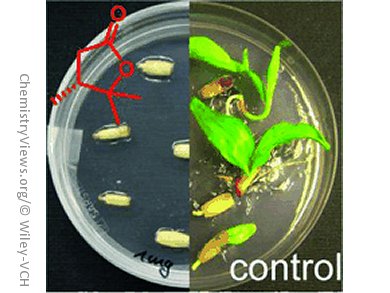Killer Fungus
The leaves wilt, the crown dies off, the bark exhibits lesions, the wood becomes discolored – the ash forests of Europe are under threat. The perpetrator is an Asian fungus, and its progress is unstoppable. In order to develop effective countermeasures, the transmission pathway, progression of the disease, and propagation of the fungus must be clarified. German researchers have now identified a metabolic product of this killer fungus that inhibits the germination of ash seeds. In the journal Angewandte Chemie, they report on possible mechanisms for this activity.
Hymenoscyphus pseudoalbidus looks almost identical to its harmless relative, Hymenoscyphus albidus, but it causes heavy damage to the common ash, Fraxinus excelsior. Over the last two decades, this killer fungus from the Far East has rapidly spread from east to west across Europe, reaching the British Isles in 2012. There is no decline of the disease in sight. Only a small subpopulation of European ash trees seems to be resistant to this fungus, but it is unclear whether this portion is large enough to ensure the survival of this ecologically and economically important tree species, which is found in nearly all of Europe and parts of Asia around the Black Sea.
Lactone Identified as the Virulence Factor
A team led by Jeroen S. Dickschat at the Technische Universität Braunschweig has extracted the volatile and nonvolatile metabolic products of the fungus and studied them by spectroscopic methods. The researchers found a suspect among the volatile compounds: in laboratory experiments, the lactone 3,4-dimethylpentan-4-olide inhibits the germination of ash seeds and causes necrosis.
Surprisingly, this compound is also found in nonpathogenic fungi. “Metabolites from the plants may play a role here by regulating the production of the lactone differently in different species of fungus,” suggests Dickschat. “This could also explain why Japanese ash trees are not affected by this fungus and some individuals of the European ash are also relatively resistant.” Another explanation could be the interaction between the lactone and certain microorganisms that are found in the European ash. “Such a mechanism would allow endophytes to act as mediators between the plant and its pathogen,” explains Dickschat. “A comparable mechanism has previously been discovered in another case: Lactones in the smoke produced by burning plants promote germination through a process in which interactions with plant bacteria might play a critical role.”
These new discoveries are important milestones in understanding ash dieback and possible mechanisms of resistance in the unaffected populations of ash. Says Dickschat: “The identification of the lactone as the virulence factor will hopefully pave the way for control of a pathogen that currently threatens the entire population of ash trees in Europe.”
- A Volatile Lactone of Hymenoscyphus pseudoalbidus, Pathogen of European Ash Dieback, Inhibits Host Germination,
Christian A. Citron, Corina Junker, Barbara Schulz, Jeroen S. Dickschat,
Angew. Chem. Int. Ed. 2014.
DOI: 10.1002/anie.201402290




